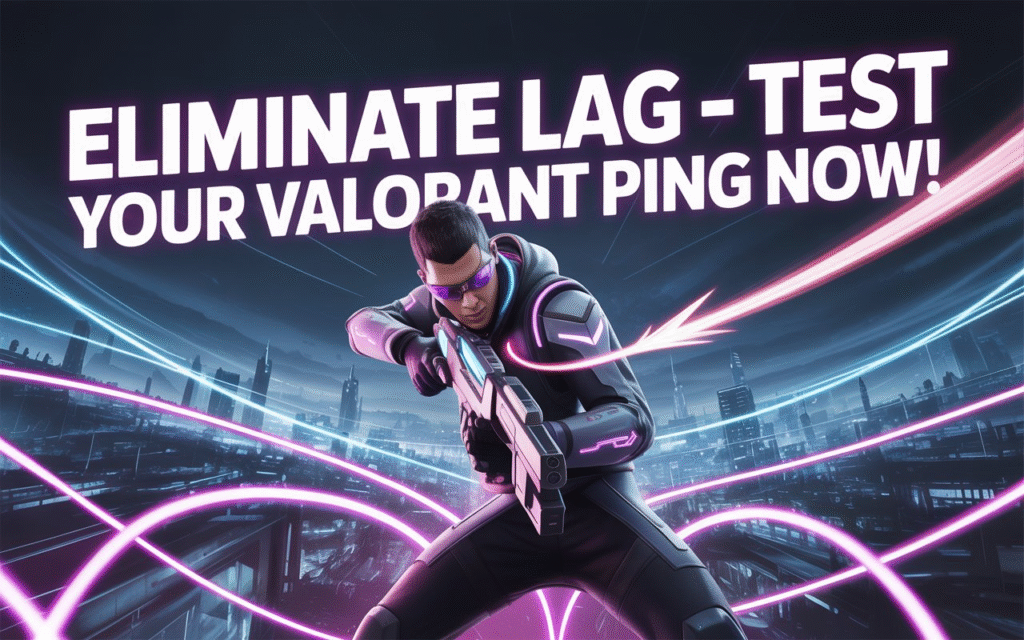Valorant has quickly become one of the most popular tactical shooters in the world. With its sharp mechanics, precise gunplay, and fast-paced action, players know that every second matters. But nothing can ruin a perfect clutch round faster than lag. High ping, unstable connections, and sudden spikes are common frustrations in the community. If you’ve ever yelled, “I swear I shot first!” then you already know the pain of Valorant lag.
The good news is you can take control of your connection. By learning how to test Valorant ping and applying smart fixes, you can minimize delays and finally enjoy smooth, frustration-free matches.
This guide explains everything: why ping matters, how to test it, the common causes of lag, and the smartest solutions to eliminate it once and for all.
Why Ping Matters in Valorant
Ping measures the delay between your computer and the Valorant game servers. It’s displayed in milliseconds (ms), and even small delays can completely change how the game feels.
Here’s how ping affects Valorant gameplay:
- 0–30 ms: Excellent – abilities and shots register instantly.
- 30–60 ms: Good – barely noticeable delay.
- 60–100 ms: Playable, but you’ll start losing close fights.
- 100+ ms: High ping – constant delays and frustrating gameplay.
Valorant is all about precision and timing. If your ping is too high, your character’s actions appear delayed, making it feel like enemies always have an advantage.
Step One: Test Valorant Ping Before Playing
Before troubleshooting, you need to know where you stand. That’s why it’s important to test Valorant ping before you queue up.
Using the GearUP Booster ping test tool, you can:
- Measure your real-time latency to Valorant’s servers.
- Detect if lag comes from your internet or from server issues.
- Compare results across different networks (Wi-Fi, Ethernet, hotspot).
- Spot potential ping spikes that cause rubber-banding during matches.
This step is critical. Instead of guessing why you’re lagging, a ping test gives you clear numbers that help you identify the problem before jumping into a game.
Why Do You Experience Valorant Lag?
Even players with strong internet connections can experience Valorant lag. Here are the most common causes:
- Wi-Fi instability – Wireless networks are prone to interference.
- Background usage – Apps like Netflix, YouTube, or downloads hog bandwidth.
- Server distance – The farther away you are from Riot’s servers, the higher your ping.
- ISP routing issues – Your internet provider may not take the most direct path.
- Congested networks – Sharing Wi-Fi with multiple devices can slow you down.
Lag isn’t always your fault. Sometimes, the issue is with Riot’s servers themselves, which is why testing your ping beforehand is so helpful.
Step Two: Fixing Valorant Lag with GearUP Booster
Once you’ve tested your ping and identified problems, the next step is to fix them. That’s where GearUP Booster’s Valorant lag solution comes in.
Here’s what it does for players:
- Smart routing – Directs your traffic through the fastest path to Riot servers.
- Stabilized connection – Reduces packet loss and ping spikes.
- One-click setup – Easy to use, no technical knowledge required.
- Worldwide optimization – Works across regions like Asia, Europe, and North America.
Instead of hoping your ISP improves routing, GearUP Booster ensures your connection is always optimized for competitive gaming. This means fewer random lag spikes and smoother, more consistent gameplay.
Simple Fixes You Can Try Yourself
Before investing in advanced tools, there are simple fixes you can try to reduce lag:
- Use a wired Ethernet connection – More stable than Wi-Fi.
- Close background apps – Stop downloads, video streams, or other devices using bandwidth.
- Restart your router – Refreshes your connection and clears potential slowdowns.
- Choose the right server – Always select the server closest to your location.
- Update network drivers – Outdated drivers can hurt connection quality.
These fixes can improve performance, but they might not completely solve the problem if routing issues or server distance are the root causes. That’s when a booster becomes essential.
How Ping Test and Game Booster Work Together
Think of this process as two steps:
- Ping test = detection. You measure your connection quality and identify problems.
- Booster = solution. You optimize your network and fix the problems.
By combining the two, you’re not just guessing. You’re testing your connection first, then applying fixes that specifically address the issues.
Why Low Ping Is a Competitive Advantage
Serious Valorant players understand that low ping isn’t just about comfort—it’s about winning. Here’s why it matters so much:
- Faster reaction times – Shoot first, win more duels.
- Accurate ability usage – Smokes, flashes, and utility land exactly when you need them.
- Better coordination – Team plays feel more synchronized.
- Consistent climbing – Stable performance makes ranked grinding smoother.
This is why pros and streamers always prioritize low and stable ping. It’s a competitive advantage you can’t afford to ignore.
FAQs
Q1: What is a good ping for Valorant?
Anything below 50 ms is excellent. Between 50–80 ms is okay, but above 100 ms is considered high ping.
Q2: How can I test Valorant ping?
You can use GearUP’s Valorant ping test to check your real-time latency before starting a game.
Q3: What causes Valorant lag even with fast internet?
Lag can come from Wi-Fi instability, server distance, or ISP routing problems—not just slow speeds.
Q4: Does GearUP Booster really fix Valorant lag?
Yes. By rerouting your connection through optimized servers, it reduces ping and stabilizes your gameplay.
Q5: Can GearUP Booster get me banned?
No. It doesn’t alter game files; it only improves internet routing. It’s safe to use.
Q6: Do boosters help if I already have good internet?
Yes. Even with high-speed internet, poor routing can cause high ping. A booster ensures you get the fastest, most stable path.
Q7: Why does my ping spike randomly in Valorant?
This usually happens due to Wi-Fi issues, bandwidth hogs, or poor routing. Testing and using a booster helps minimize these spikes.
Final Thoughts
High ping and lag can ruin your Valorant experience, but they don’t have to. The smartest way to take control is to test Valorant ping regularly and identify issues before you play. Once you know where the problem lies, tools like GearUP Booster’s Valorant lag solution can optimize your connection, stabilize ping, and ensure smoother gameplay.
Don’t let lag cost you another round. Start testing, boosting, and playing with confidence—because smoother gameplay means smarter plays, and smarter plays win games.


